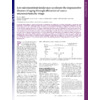 |
|
Lecture Notes | Approved: 7 years ago | 343.88 kB | Comments: 0
...LowmicronutrientintakemayacceleratethedegenerativediseasesofagingthroughallocationofscarcemicronutrientsbytriageBruceN.Ames*NutritionandMetabolismCenter,Children’sHospitalofOaklandResearchInstitute,5700MartinLutherKingJr.Way,Oakland,CA94609ContributedbyBruceN.Ames,October6,2006(sentforreviewSeptember20,2006)Inadequatedietaryintakesofvitaminsandmineralsarewidespread,mostlikelyduetoexcessiveconsumptionofenergy-rich,micro-nutrient-poor,reÞnedfood.Inadequateintakesmayresultinchronicmetabolicdisruption,includingmitochondrialdecay.DeÞcien-ciesinmanymicronutrientscauseDNAdamage,suchaschromosomebreaks,inculturedhumancellsorinvivo.SomeofthesedeÞ-cienciesalsocausemitochondrialdecaywithoxidantleakageandcellularagingandareassociatedwithlateonsetdiseasessuchascancer.IproposeDNAdamageandlateonsetdiseaseareconsequencesofatriageallocationresponsetomicronutrientscarcity.Epi-sodicshortagesofmicronutrientswerecommonduringevolution.Naturalselectionfavorsshort-termsurvivalattheexpenseoflong-termhealth.Ihypothesizethatshort-termsurvivalwasachievedbyallocatingscarcemicronutrientsbytriage,inpartthroughanadjustmentofthebindingafÞnityofproteinsforrequiredmicronutrients.Ifthishypothesisiscorrect,micronutrientdeÞcienciesthattriggerthetriageresponsewouldacceleratecancer,aging,andneuraldecaybutwouldleavecriticalmetabolicfunctions,suchasATPproduction,intact.Evidencethatmicronutrientmalnutritionincreaseslateonsetdiseases,suchascancer,isdiscussed.Amul-tivitamin-mineralsupplementisonelow-costwaytoensureintakeoftheRecommendedDietaryAllowanceofmicronutrientsthroughoutlife.oornutritionhasbeenlinkedtoanincreasedriskofmanydis-eases,includingcancer,heartdisease,anddiabetes.Thehu-mandietrequiresbothmacronutrients,whicharethemainsourceofcalories,andmicronutrients(40essentialmin-erals,vitamins,andotherbiochemicals),whicharerequiredforvirtuallyallmet-abolicanddevelopmentalprocesses.TheleadingdietarysourcesofenergyintheUnitedStatesareabundantincarbohy-dratesandfats(1)butdeficientinmi-cronutrients(i.e.,theyareenergy-denseandnutrient-poor)(2).Suchfoodsareinexpensiveandtastyandasaconse-quenceareconsumedexcessively,partic-ularlybythepoor(3).Thus,evenintheUnitedStates(4),inadequateintakeofsomevitaminsandmineralsiscommon(Table1).Suboptimalconsumptionofmicronutrients(4)oftenaccompaniescaloricexcess(6,88)andmaybethenormamongtheobeseandcontributetothepathologiesassociatedwithobe-sity.Significantchronicmetabolicdisrup-tionmayoccurwhenconsumptionofamicronutrientisbelowthecurrentRec-ommendedDietaryAllowance(RDA)(7–10)butabovethelevelthatcausesacutesymptoms.Whenonecomponentofthemetabolicnetworkisinadequate,theremaybeavarietyofrepercussionsinmetabolism,includingaccelerationofdegenerativediseases.Theoptimumin-takeofeachmicronutrientnecessarytomaximizeahealthylifespanremainstobedeterminedandcouldevenbehigherthanthecurrentRDA,particularlyforsomepopulations(7,10).Forexample,folicacidintakesabovetheRDAap-peartobenecessarytominimizechro-mosomebreaks(10,11).MicronutrientDeficienciesMayAccelerateMitochondrialDecayandDegenerativeDiseasesofAging,SuchasCancerMitochondrialdecayappearstobeamajorcontributortoaginganditsasso-ciateddegenerativediseases,includingcancerandneuraldecay(12).Mitochon-driafromoldratscomparedwiththosefromyoungratsgenerateincreasedamountsofoxidantby-products(13)andhavedecreasedmembranepotential,respiratorycontrolratio,cellularoxygenconsumption,andcardiolipin(akeylipidfoundonlyinmitochondria).Oxi-dativedamagetoDNA,RNA,proteins,andlipidsinmitochondrialmembranescontributestothisdecay(9,13–16)andleadstofunctionaldeclineofmitochon-dria,cells,tissues,andeventuallyorganssuchasthebrainwithanaccompanyinglossofambulatoryactivity(9,13–16).Theimportanceofoptimizingmeta-bolicfunctiontopreventmitochondrialdecayisillustratedbyfeedingthemito-chondrialmetabolitesacetylcarnitine(ALC)andlipoicacid(LA)tooldrats.Carnitineisusedfortransportingfattyacidsintothemitochondria;themainformofcarnitineintheplasmaisALC.LAisamitochondrialcoenzymeandis Authorcontributions:B.N.A.wrotethepaper.Conßictofintereststatement:B.N.A.isafounderofJu-venon,acompanythathaslicensedtheUniversityofCali-forniapatent(B.N.A.andT.Hagen,inventors)onacetylcarnitinepluslipoicacidforrejuvenatingoldmitochondria.Juvenonsellsacetylcarnitinepluslipoicacidsupplementsanddoesclinicaltrialsonthem.B.N.A.ÕsfounderÕsstockwasputinanonproÞtfoundationatthefoundingin1999.HeisdirectorofJuvenonÕsScientiÞcAdvisoryBoard,buthehasnostockinthecompanyanddoesnotreceiveanyremu-nerationfromthem.*E-mail:bames@chori.org.©2006byTheNationalAcademyofSciencesoftheUSATable1.SelectedmicronutrientinadequacyintheU.S. NutrientPopulationgroup%ingestinglessthantheEARfromfood IronWomen14Ð50yearsold16MagnesiumAll56ZincAll12B6Women71yearsold49FolateAdultwomen16EAll93CAll31LessthantheEARisusedasameasureofinadequacyinpopulations(4,5).TheRDAisdeÞnedas2standarddeviationsabovetheEAR.DataarefromMoshfeghetal.pnas.0608757103PNASNovember21,2006vol.103no.4717589Ð17594...
...IronWomen14Ð50yearsold16MagnesiumAll56ZincAll12B6Women71yearsold49FolateAdultwomen16EAll93CAll31LessthantheEARisusedasameasureofinadequacyinpopulations(4,5).TheRDAisdeÞnedas2standarddeviationsabovetheEAR.DataarefromMoshfeghetal.pnas.0608757103PNASNovember21,2006vol.103no.4717589Ð17594 PERSPECTIVE reducedinthemitochondriatoapotentantioxidant.LAisalsoaneffectivein-ducerof200phase2antioxidantandthiol-protectiveenzymes,includingthoserequiredforglutathionesynthesis(17–19).ALCandLAwhenaddedasasup-plementcanact,insomecasessynergis-tically,torestoremuchofthelostmitochondrialfunctioninoldrats(13–16),whichappearstorejuvenatethemitochondriaandimprovecognitionandotherfunctions(9,13–16).Onepossiblemechanismofmitochon-drialdecayisthat,withage,increasedoxidativedamagetomitochondrialpro-teinscausesstructuraldeformationofkeyenzymesthatlowerstheiraffinityfortheenzymesubstrate(16).FeedingoldratsthesubstrateALCwithLAforafewweeksdecreasesoxidativedamage,allow-ingthesynthesisofnewcarnitineacyltransferasewithnormalbindingaffinity).Thispartiallyrestoresmitochondrialfunction;decreasesoxidants,neuronalRNAoxidation,andmutagenicaldehydes;andincreasesratambulatoryactivityandcognition(13–16).ALCandLAarenotthoughtofasmicronutrients,becausetheycanbesynthesizedinthebody,buttheyareillustrativeofmanynormalmetabo-litesthatmaybebeneficialintheelderly.Theassociationofseveralmicronu-trientdeficiencieswithdegenerativedisease,DNAdamage,cancer,andmi-tochondrialdecayisdiscussedbelow.MagnesiumDeficiency.Magnesiumintakes56%ofadultsintheUnitedStatesarebelowtheEstimatedAverageRe-quirement(EAR)(Table1).IntakesbelowtheEARareespeciallyprevalentamongthepoor,teenagers(78%of14-to18-year-oldmalesand91%of14-to18-year-oldfemales),theobese,AfricanAmericans,andtheelderly(81%)(4,20–24).Inhumans,magnesiumdeficiencyhasbeenassociatedwithcolorectalandothercancers(25–28),hypertension,osteoporosis,diabetes,andthemetabolicsyndrome(5,29,89).Inastudyof4,035menfollowedfor18years,thehighestquartilewithserummagnesiumatbaselinecomparedwiththelowesthada40%decreaseinall-causemortalityandcardiovasculardis-easeanda50%decreaseincancerdeaths(30).Inprimaryhumancellsinculture,magnesiumdeficiencyleadstomitochondrialDNAdamage,acceler-atedtelomereshortening,activationofcell-cyclearrestproteins,andprematuresenescence(D.W.Killilea,B.N.A.,un-publishedobservations).Magnesiumde-ficiencyinratsleadstochromosomebreaks(31)andcancer(25).Inrats,adietmoderatelydeficientinmagnesiumincreasedmortality,bloodpressure,in-flammation,andoxidantsanddecreasedresistancetooxidantscomparedwithastandardormagnesium-supplementeddiet(32).Thisevidencesuggeststhatsupplementationprogramsshouldbeconsidered,becausethereislittleriskofmagnesiumtoxicity(5).Astandardmul-tivitamin–mineral(MVM)supplementdoesnotcontainsufficientmagnesium(orcalcium)becauseitwouldmakethesupplementtoobulky.VitaminDDeficiency.ThedarkskinofpeopleindigenoustosouthernIndia,Africa,andothertropicalregionspro-tectsagainstexcessiveUVlightexpo-surefromthesun.Ontheotherhand,darkskininterfereswiththeformationofvitaminDintheskin,whichrequiresUVlight.Thus,dark-skinnedpeopleinnorthernlatitudesareoftenvitaminD-deficient.Forexample,AfricanAmeri-cansasagroupareparticularlydeficientinvitaminD(33,34).InTheNether-landsthereisaveryhighlevelofvita-minDdeficiencyduringpregnancyindark-skinnedwomen(35,36).Inade-quacyisprevalentinCaucasiansaswell(37).VitaminDdeficiencyhasbeenes-timatedtoaccountfor29%ofcancermortalityinmales(38)andhasbeenstronglyassociatedwithcolon,breast,pancreatic,andprostatecancer(38–44).Italsohasbeenassociatedwithavari-etyofdiseaseswithlonglatencyperiods,includingcardiovasculardisease(45–51).Astudyofindependent,community-dwellingelderlypeoplereportedthatnursinghomeadmissions,andpossiblymortality,werestronglyassociatedwithvitaminDinadequacy(52).Alargepro-spectivestudy(50)inwomenreportedthatintakesof400I.U.ofvitaminDperdayfromsupplementswasassoci-atedwitha41%lowerriskofmultiplesclerosiscomparedwithwomenthatdidnotconsumevitaminDfromsupple-ments.ItwasnotpossibletodefinitivelyattributetheeffecttovitaminD,be-causeitwasmostlyconsumedinMVMsupplements,whichwerealsoassociatedwithlowerrisk;theauthorsconcludedthatvitaminDwasthemostlikelyex-planation.SomeevidenceinhumansandrodentssuggeststhatvitaminDde-ficiencyisassociatedwithcognitivedys-function(90,91).NumerousauthorshavesuggestedthateffortstoimprovevitaminDstatusbysupplementationcouldreducediseaseincidenceandmor-talityatlowcostwithfewornoadverseeffects(39,41,49,53).ManyexpertssuggestthecurrentRDAforvitaminDshouldberaised(54,55).OtherMicronutrientDeficienciesAssociatedwithChronicDegenerativeDiseases.ciumdeficiencyiscommon;ithasbeenassociatedwithchromosomebreaks(56)anddiabetes(48)inhumansandcoloncancerinmice(57).SeleniumdeficiencyinmiceinducesgeneslinkedtoDNAdamageandoxidativestress(58),andithasbeensuggestedthatseleniumpro-tectsagainstcancer(59,60).Potassiumintablesaltinelderlymenwasassoci-atedwitha40%decreaseincardiovas-culardiseasecomparedwithnormaltablesaltinarandomizedcontrolledtrial(RCT)(61).Omega-3fattyaciddeficiencyisassociatedwithmelanomaandothercancers(62)aswellascogni-tivedysfunction(63).TheeffectofBvitamindeficiencyonmitochondriawasreviewedrecently(64).VitaminB12de-ficiencyiscommoninthepopulation(4);itisassociatedwithcognitivedys-function(65)andmultiplesclerosis(66)andinduceschromosomebreaks(11).ThecognitivedysfunctionassociatedwithB12deficiencyimprovedwithsup-plementationwithinthefirstyearofon-set(67).Folatedeficiencyalsocauseschromosomebreaks(11,56,68)andisassociatedwithseveralhumancancers(69,70).Marginalthiaminedeficiencyinratsinducestheformationofcolonicaberrantcryptfoci,apreneoplasticle-sioninamodelfordetectingcoloncar-cinogens(64).Thiaminedeficiencyisalsoassociatedwithbraindysfunctionanddiabetes(64).Niacindeficiencyincellularandanimalstudiesappearstobegenotoxic(64,71).Cholinedefi-ciencyinhumansincreasesDNAdam-ageinlymphocytes(72).Inrats,cholinedeficiencyhasbeenassociatedwithbraindysfunction(73),oxidantrelease,andmitochondrialdamage(72).WeandothersdiscussedtheneedtosetmicronutrientrequirementshighenoughtominimizeDNAandmito-chondrialdamage(7,8,10,11,56,64,74).Foreachmicronutrientwearein-vestigatingthelevelofdeficiencythatcausesDNAandmitochondrialdamageinhumansbecauseneitherstudiesusinghumancellsinculturenorstudiesusingrodentscanprovidethisinformation.EndpointssuchasDNAdamageinhu-mansmightbeusefulindicatorsforre-finingEARsandupperlimits(ULs)tomorecloselyapproximatethelevelsre-quiredforoptimalhealth.SomeMicronutrientDeficienciesImpairHemeSynthesis,WhichCanResultinMito-chondrialDecay,DNADamage,andCellSevenmicronutrients(pyri-doxine,pantothenate,zinc,riboflavin,iron,copper,andbiotin)arerequiredforhemesynthesisinmitochondria(Ta-ble2).ItislikelythatadeficiencyinanyofthesesevenwillcauseadeficitofhemeandthereforeofcomplexIV,ofwhichheme-isanessentialcomponent(7,8,75,83,85,86).Theresultstodate areinTable2.ThenormalcomplementofcomplexIVkeepsoxidantstoamini-mum;deficitsofcomplexIVresultinoxidantleakage,DNAdamage,acceler-atedmitochondrialdecay,andcellularaging(8,83,85).Table2isincompletebecausetheeffectsofsomedeficienciesonhumancellsinculturehavenotyetbeendetermined.Deficienciesofiron,zinc,andbiotinarediscussedbelow.Irondeficiencyisthemostcommonmicronutrientdeficiencyintheworld,andanemiaiswidespreadinunderde-velopedcountries(87).IronintakeinU.S.menstruatingwomenislow;arebelowtheEAR(4).Hispanicwomenandtheobeseareatgreaterriskofbeingiron-deficient(6).Inhumans,irondeficiencyanemiaisassociatedwithpoorcognitivedevelopmentintoddlers(92),suggestingthatirondeficiencyinhumansduringcriticalperiodsofdevel-opmentharmsthedevelopingbrain(92).SevereirondeficiencycauseslossofmitochondrialcomplexIVinselectedregionsinthebrainofneonatalrats(93)andotherchangesinfunction,mor-phology,andphysiologyofthebrain(88,94).Irondeficiencyinratsdamagesmitochondriaandcausesoxidantre-lease,oxidativeDNAdamage,andde-creasedmitochondrialefficiency(79).Irondeficiencyalsoisassociatedwithdiminishedimmunefunctionandneuro-muscularabnormalities(95,96).Theprimarymeasureusedtoidentifyirondeficiencyinmosthumanpopulationsisareductioninhemoglobintothepointofanemia(malaria,HIV,andothernutrientdeficienciesmayalsoleadtoanemia).Theeffectsofirondeficiencyoccuralongacontinuum(88,97),andsubclinicalirondeficiencymayhavedel-eteriouseffectsonhemebiosynthesis.Irondeficiencywithoutanemiacanalsooccurinnewbornsexposedtointrauter-inehypoxia,suchasinfantsofpre-eclampticordiabeticmothers(98).Insuchcases,ironisprioritizedtoery-throidandhemoglobinsynthesis,puttingthenonerythroidtissuesatriskofirondeficiencyandhencehemedeficiency(99,100).Dietaryirondeficiencyintheabsenceofanemiadecreasesaerobiccapacityandphysicalworkperformance,whichareimprovedbyironsupplemen-tation(101).Irondeficiencyhasnotbeenadequatelystudiedasapossibleriskfactorforcancer,andtheresultsarediscordant(102).However,manystudiesarelookingforamonotonicre-lationshipanddonottakeintoaccountthatonemightexpectcanceratlevelsofironthatarebothtoolowandtoohigh(79),asinhereditaryhemochromatosis,aknownriskfactorforcancer(103).Zincinadequacyiscommonin12%ofwhomarebelowtheEAR(4).Inhumancellsinculture,zincdeficiencycausescomplexIVdeficiencyandthereleaseofoxidants,resultinginsignificantoxidativedamagetoDNA(76–78).Zincdeficiencyalsocauseschromosomebreaksinrats(31)andisassociatedwithcancerinbothrodentsandhumans(104).Asdiscussedabove,theseobservationsreinforcetheneedtodeterminewhatdegreeofdeficiencyinhumansresultsinDNAdamage.Wethinkitislikelythatthetriggerfordecreasedhemesynthesisistheinactiva-tionofthesecondenzymeofthepath--aminolevulinatedehydratase,whichcontainseightatomsofzinc(85,105).Zincdeficiencyinhumancellsalsoinactivatesotherzinc-containingpro-teinssuchasthetumorsuppressorpro-teinp53andtheDNAbaseexcisionrepairenzyme,apyrimidinicapurinicendonuclease,witharesultingsynergis-ticeffectongeneticdamage(76,77).Biotindeficiencyismorecommonthanpreviouslythought;40%ofpreg-nantwomenwhodonottakeamultivi-taminshowmetabolicsignsofdeficiency(106).Marginalbiotindeficiencyistera-togenicinmice(106).Biotinisapros-theticgroupinfourbiotin-dependentcarboxylases(threeofwhicharesolelypresentinmitochondria)thatreplenishintermediatesinthetricarboxylicacidcycle(107).Biotindeficiencydecreasestheactivityoftheseenzymes,leadingtoadecreaseoftwohemeprecursors,mi-tochondrialsuccinyl-CoAandglycine,thusresultinginhemedeficiency(83).Biotindeficiencyinnormalhumanlungfibroblastsinculturecauseda40–50%decreaseinhemecontent,oxidantre-lease,prematuresenescence,andDNAdamage(83).Therelationshipoftheseeffectstohumanintakeneedstobede-termined(108).ANewHypothesis:AllocatingaScarceMicronutrientbyTriageIsthereanexplanationfortheobserva-tionthatmanymicronutrientdeficien-ciesareassociatedwithchromosomebreaksandcancerinhumans,causeDNAdamageinrodentsorhumancellsinculture,and,whereassayed,causeearlysenescence?IproposeDNAdamageandlateonsetdiseasearecon-sequencesofatriageallocationmecha-nismdevelopedduringevolutiontocopewithepisodicmicronutrientshort-ages.Forexample,livingcreaturesalwayshaverequired15metals/miner-alsfortheirmetabolism,whicharedis-tributedveryunevenlythroughouttheEarth.Thus,episodicshortagesprobablywerecommon,asprobablyalsowasthecaseforvitaminsandotheressentialmicronutrients.Naturalselectionisknowntofavorshort-termsurvivalattheexpenseoflong-termhealthwhentheyareinconflict.Ihypothesizethatasthescarcityofamicronutrientin-creases,andafterhomeostaticadjust-ments,suchasinductionoftransportproteins(109),atriagemechanismforallocatingscarcemicronutrientsisacti-vatedthatfavorsshort-termsurvivalattheexpenseoflong-termhealth,inpartthroughanadjustmentofthebindingaffinityofeachproteinforitsrequiredTheconsequencesofsuchtriagewouldbeevidentatalllevels.Forexam-ple,inmetabolicreactions,enzymesinvolvedinATPsynthesiswouldbefa-voredoverDNA-repairenzymes;incells,erythrocyteswouldbefavoredoverleukocytes;andinorgans,theheartwouldbefavoredovertheliver.Isozymeswithdifferentbindingcon-stantsforthecoenzymeormetalintheheartorlivercouldbeoneofseveralwaystoaccomplishthisend.Physiologi-caltriageiswellknown:‘‘whenOliverytothetissuesisinadequate...vitalorganfunctionismaintainedbyintrinsicneurohormonalcompensatorymechanismsresultingindistributionoforganbloodflowprimarilytotheheart,brain,andadrenalglandsandawayfromother‘nonvital’organs’’(110).Similarly,underconditionsofdeficiency,organssuchastheliverlosecertainmi-cronutrientsfirst,beforeothermorevi-talorgans(111–116,150).Table2.MicronutrientdeÞciencyandheme:effectsonhumancellsincultureandanimals ComplexIVPyridoxine7576Ð7876Ð78Riboßavin75Iron7979Copper808182Biotin8383838383Pantothenate7584Numbersrepresentreferences.,H.Atamna,S.Askree,andB.N.A.,unpublisheddata.November21,2006vol.103no.47 Thetriagehypothesissuggestsaddi-tionalmechanismsthatmaybeusedbythebodytoallocatescarceresources.Thishypothesisistestable,and,ifvali-dated,suggeststhatitmaybenecessarytooptimizeintakesofmicronutrientsaccordingtotheneedsofthemostdis-pensableorganorcellsinordertomaxi-mizelongevityandretardcancerandotherdegenerativediseasesofaging.Thereisincreasingevidencethatnutri-tionalinadequaciesduringdevelopmentcanhaveconsequenceslaterinlife(117).Forexample,fetalmalnutritionduringtheDutchfaminein1944–1945wasassociatedwithcoronaryarterydis-easeinadulthood(117,118),althoughbothmicronutrientandmacronutrientmalnutritionmayhavecontributedtothislate-onsetdisease.Broadly,suchproteintriagewouldrepresentanin-stanceof‘‘antagonisticpleiotropy,’’asproposedalmost50yearsagobyWil-liams(119)inwhichasingleallele(e.g.,anisozymewithalowaffinityforami-cronutrient)mayencodebothabenefi-cial(short-termsurvivalofepisodicdeficiency)andaharmful(anincreaseindegenerativedisease)phenotype.Theconceptofenzymetriageisalsobroadlyconsistentwithrecentevolutionarythe-oryaboutaging,whichstressesthatse-lectionforreproductivesuccessearlyinlifemayinvolvetrade-offsthatshortenlifespan(120).Malnutritionhasbeendiscussedinrelationto‘‘investmentpri-orities’’inbirds(151),fetalprogram-minginhumans(152,153),andtypeofimmunocompetence(154).Moderatereductionindietaryintakeofmacronutrients(calorierestriction)withadequatemicronutrientsextendslifespaninvariousanimals(121)butisnotinconsistentwiththetriagehypoth-esisbecausethenormallevelofcalo-riesfedcontrolscouldbeinexcessofwhatisoptimalformaximumlifespan.ShouldPeopleTakeanMVMSupplementforInsurance?TheNationalHealthandNutritionEx-aminationSurveys(NHANES)(4)indi-catethatthedietsofmanyintheUnitedStatesdonotprovideadequateintakesofallofthevitaminsandminer-alsrecommendedbyofficialbodies(Ta-ble1).FromNHANESandTable1,itseemslikelythatactualintakesofvari-ousmicronutrientsfromfoodarenotonlyinadequateforthepoor,teenagers,menstruatingwomen,theobese,andtheelderly,butformuchoftherestofthepopulationaswell.However,decadesofpublichealtheffortstoimprovetheAmericandiethavenotbeenverysuc-cessful,particularlyamongthepoor.WhynotrecommendthataMVMsup-plementbeaddedtoahealthylifestyle?Thisapproach,focusingonmicronutri-entmalnutrition,withadditionalatten-tiontofoodfortification,inadditiontocontinuingeffortstoimprovediet,mightbemoresuccessfulinimprovinghealth.ItmaybeeasiertoconvincepeopletotakeaninexpensiveMVMsupplementthantomarkedlychangetheireatinghabits.EvidenceisaccumulatingthataMVMsupplement,orsmallercombina-tionsofvitaminsandminerals,alsoim-provelong-termhealth,reducingheartdisease,cancer,andcataractsandim-provingimmunefunctionforthosewhoconsumeinadequatediets(122–137,155).ThepotentialbenefitsofanMVMininfectionhavebeencriticallyreviewed(138).Shoulditbenecessarytofirstdemon-strateefficacyforpreventingordelayinglong-termchronicdiseasessuchascan-cerinRCTsbeforerecommendingMVMuse(45,156)?RCTsformicronu-trientsandlong-termeffectsareex-tremelydifficulttodocorrectlyformanyreasons(45):decadesaresome-timesrequiredinlonglatencydiseases(139,140);therearedifferent,andoftenmultiple,consequencesofeachmicronu-trientdeficiency;largepopulationsarerequired;thistypeofRCTisveryex-pensive,and,unlikefordrugs,thereisnocommercialincentivetodotrials;andcomplianceisdifficulttomaintainformanyyears,particularlyincontrols,whocantakereadilyavailableMVMsupplements.Forallofthesereasonsitisunlikelythatitwillbepossibletoob-taindefinitiveresultsfromthistypeofRCT,whetheritbetargetedatsinglemicronutrientsorMVMs.Forexample,twoverylargeRCTsexaminedeffectsofsupplementationwithalimitednum-berofvitaminsandmineralsoncancerrisk(134,135).AlthoughbothoftheseRCTsreportedareductionincancerincidenceormortalitywithsupplemen-tation,methodologicalconcernshavebeenraisedtoarguethattheresultsarenotdefinitive(156).Insteadofrelyingonlyonlong-termRCTs(156),allscientificevidenceshouldbetakenintoaccountinmakingsupplementationrecommendations(45,141).RCTsonshort-termendpointssuchasDNAdamage(10)ormarkersofinflammation(125)arefeasibleandaremorelikelytoyielddefinitivere-sults.Manyothertypesofexperimentsinhumansandanimals,includingbio-chemical,mechanistic,andepidemiolog-ical,arealsorelevant.OnedoesneedtobeconcernedthatcumulativeeffectsofsupplementationandfortificationmightexceedULs.In-creasingconsumptionofsupplementsandincreasingfortificationemphasizetheneedforvigilancetopreventover-consumptionofcertainmicronutrients.Forexample,consumingtoohighadoseofmanyofthemineralsistoxic(e.g.,iron,zinc,copper,andselenium,andsomeofthevitamins,suchasvitaminA).VitaminAwasofparticularconcernuntilmostMVMmanufacturersswitchedrecentlytousingmoreprovita-minA.Excessironisalsonotdifficulttoachieveinmenandpostmenopausalwomen,whoshouldtakereadilyavail-ableMVMswithoutironandshouldlimitredmeatconsumption.Inmice,bothlow(one-thirdofnormal)intakeofamixtureofvitaminsanda5-foldex-cesscausedanincreaseinintestinalneo-plasia(142).Inrats,bothtoolittleandtoomuchironresultedinmitochondrialdamage,releaseofoxidants,andDNAdamage(79).However,thepercentageofthepopulationconsumingmorethantheULfromfoodisverylowcomparedwiththepercentageconsuminglessthantheEAR(4).Thus,micronutrientdefi-cienciesarelikelytobeafarmoreim-portantpublichealthproblemthanexcessconsumption(4).Thisconclusionissupportedbythemanyepidemiologi-calandotherhumanstudiescitedinthisarticle.Thus,takingadailystandardMVMsupplementisunlikelytobeofconcern,becausetheseamountsofmi-cronutrientsarenotclosetotheUL(4).Despitethelackofdefinitiveproofofefficacy,IandothersbelievethatpublichealthofficialsandphysiciansshouldrecommendthatpeopletakeaMVMsupplementinadditiontoleadingahealthylifestyle(133):therearewide-spreadlowintakes(4);animpressivearrayofevidenceforMVMsupplemen-tationexists,andthereisanabsenceofrealisticsafetyconcerns.Ifthissimplechangecouldbeimplemented,andpar-ticularlyifMVMscouldbemadeavail-abletothepoor,amarkeddecreaseintheprevalenceofmicronutrientintakesbelowtheRDAwouldresult.Fortificationoffood,suchasfolatefortification,isanotherapproachthathasbeenshowntoimprovehealthandisvaluable.Fortification,however,mightnotbesufficientforpopulationsub-groupsthathavespecialneeds.Forex-ample,mostAfricanAmericansareverylowinvitaminDdespitemilkfortifica-tion(33);75%arelactose-intolerant(53);anditseemsprudentforAfricanAmericanstotakeavitaminDorMVMsupplement(54).Fortificationisalsoproblematicwhensomegroupsinthepopulationwouldbebenefitedandsomeharmed.Thisisrelevantforiron,be-causemenstruatingwomenneedmorethanmenorolderwomen,someofwhommaybegettingtoomuch. OtherPossiblyUsefulSupplementsOtherusefulsupplementsincludefiber,andomega-3fattyacidsfromfishoil,particularlyeicosapentaenoicacidanddocosahexaenoicacid,whichappeartobeimportantforbrainfunctionandhavepotentantiinflammatoryactivity(63,141,143).Inadequatefiberintakes,bothsolubleandinsoluble,arewide-spreadandhaveadversehealthconse-quences(144);supplementationisinexpensive.AdvicetotakeMVMsup-plements,fiber,andomega-3fattyacidsupplementsshouldalwaysbecoupledwithadvicetoeatagooddiet,becausewealsoneedothernutrientsandproba-blyphytochemicalsthatmaynotbepresentinsupplements(145).VariableOptimalRequirementsTheelderlymayneedmoreorlessofcertainvitaminsandmetabolitescom-paredwithyoungerpeople,butthisis-suehasnotbeenthoroughlyexamined(146,147).Forexample,25%ofDutchadults70yearsofageshowedmild-to-severevitaminB12deficiency(148),mostlikelybecauseofmalabsorp-tionratherthanlowdietaryintakes(4).VitaminB12intakesatlevelsmanytimestheRDAreversedthedeficiency(65,148).Mostsmokershaveaninade-quateintakeofvitaminC;76%arebe-lowtheEAR(4).Theoptimalintakeofmicronutrientsandmetabolitescanalsovarywithgeneticconstitution(146,147,149)(e.g.,ironrequirementsvarywithageandgenderasdiscussedabove).Astudyofacommonpolymorphisminthegeneformitochondrialmanganesesu-peroxidedismutasedemonstratedthatselenium,-tocopherol,orlycopeneprotectedagainstprostatecancer,andthecombinationofallthreeshoweda10-foldgradientofriskacrossquartilesinoneformofthepolymorphism(149).AvarietyofMVMsupplementshavebeendevelopedthatreflectdifferentneedsdependingonone’sageandgen-der,andmorearelikelytobedevelopedwithnewknowledge.Althoughmanyresultsarenotdefinitiveandmuchmoreresearchisneeded,alargeliteraturesuggeststhatmicronutri-entinadequacycanleadtocancerandotherlong-termdeleteriousconse-quences.Ipresentatriagetheorythatexplainswhytheseconsequencesmightbeexpected.Short-termRCTsusingendpointsassociatedwithlong-termdisease,suchasDNAdamageandin-flammatorymarkers,arelikelytoiden-tifypopulationsatriskandfurtherrefinelevelsofmicronutrientsrequiredforoptimumlong-termhealth.Micronu-trientinadequaciesarewidespreadinthepopulation,andaMVMsupplementisinexpensive.Asolutionistoencour-ageMVMsupplementation,particularlyinthosegroupswithwidespreaddefi-cienciessuchasthepoor,teenagers,theobese,AfricanAmericans,andtheel-derly,inadditiontourgingpeopletoeatamorebalanceddiet.IamindebtedtoG.Ames,S.Askree,H.Atamna,K.Beckman,G.Block,B.German,L.Gold,H.Helbock,D.Killilea,J.King,T.Klask,A.Lal,G.Li,M.Mietus-Snyder,J.Nides,M.Stampfer,J.Suh,J.Vance,F.Vit-eri,P.Wakimoto,W.Willett,andespeciallytoJ.McCannfortheirsuggestionsandcon-tributions.ThisworkwassupportedbyNationalFoundationforCancerResearchGrantM2661,NationalCenterforMinorityHealthandHealthDisparitiesGrantP60MD00222,NationalCenterforComplemen-taryandAlternativeMedicineGrantR21AT001918,andResearchScientistAwardK05AT001323.1.BlockG(2004)JFoodCompositionAnal17:439–447.2.KantAK(2000)AmJClinNutr72:929–936.3.KarpR(2006)inModernNutritioninHealthand,edsOlsonJA,ShikeM,RossAC(LippincottWilliams&Wilkins,NewYork),pp861–874.4.MoshfeghA,GoldmanJ,ClevelandL(2005)WhatWeEatinAmerica,NHANES2001–2002:UsualNutrientIntakesfromFoodComparedtoDietaryReferenceIntakes(U.S.DepartmentofAgricultureAgriculturalResearchService,Washington,DC).5.StandingCommitteeontheScientificEvaluationofDietaryReferenceIntakes,FoodandNutri-tionBoard,InstituteofMedicine(1997)DietaryReferenceIntakesforCalcium,Phosphorus,Mag-nesium,VitaminD,andFluoride(NatlAcadPress,Washington,DC),pp190–249.6.NeadKG,HaltermanJS,KaczorowskiJM,AuingerP,WeitzmanM(2004)Pediatrics114:104–108.7.AmesBN(2005)EMBORep6:S20–S24.8.AmesBN,AtamnaH,KillileaDW(2005)AspectsMed9.AmesBN,LiuJ,AtamnaH,HagenTM(2003)ClinNeurosciRes10.FenechM(2003)NutrResRev16:109–122.11.FenechM(2005)12.ShigenagaMK,HagenTM,AmesBN(1994)ProcNatlAcadSciUSA13.HagenTM,LiuJ,LykkesfeldtJ,WehrCM,IngersollRT,VinarskyV,BartholomewJC,AmesBN(2002)ProcNatlAcadSciUSA99:1870–1875.14.HagenTM,MoreauR,SuhJH,VisioliF(2002)AnnNYAcadSci15.LiuJ,HeadE,GharibAM,YuanW,IngersollRT,HagenTM,CotmanCW,AmesBN(2002)ProcNatlAcadSciUSA99:2356–2361.16.LiuJ,KillileaDW,AmesBN(2002)ProcNatlAcadSciUSA99:1876–1881.17.SuhJH,ShenviSV,DixonBM,LiuH,JaiswalAK,LiuRM,HagenTM(2004)ProcNatlAcadSciUSA18.SuhJH,WangH,LiuRM,LiuJ,HagenTMArchBiochemBiophys423:126–135.19.SmithAR,ShenviSV,WidlanskyM,SuhJH,HagenTM(2004)CurrMedChem20.WakimotoP,BlockG(2001)JGerontolABiolSciMedSci56:65–80.21.FoxCH,MahoneyMC,RamsoomairD,CarterCA(2003)JNatlMedAssoc22.VaqueroMP(2002)JNutrHealthAging23.FordES(1998)EthnDis8:10–20.24.U.S.DepartmentofAgricultureAgriculturalRe-searchService.(1999)DataTables:FoodandNutrientIntakesbyIncome,1994–96.Availableatwww.foodsurveyhtm.Ac-cessedSeptember20,2006.25.HartwigA(2001)MutatRes26.FolsomAR,HongCP(2006)AmJEpidemiol27.LarssonS,BergkvistL,WolkA(2005)JAmMed293:86–89.28.BlondellJM(1980)MedHypotheses6:863–871.29.HeK,LiuK,DaviglusML,MorrisSJ,LoriaCM,VanHornL,JacobsDR,Jr,SavagePJ(2006)30.LeoneN,CourbonD,DucimetiereP,ZureikMEpidemiology17:308–314.31.BellLT,BranstratorM,RouxC,HurleyLSTeratology32.BlacheD,DevauxS,JoubertO,LoreauN,SchneiderM,DurandP,ProstM,GaumeV,AdrianM,LaurantP,BerthelotA(2006)RadicalBiolMed33.HarrisSS(2006)JNutr136:1126–1129.34.Nesby-OdellS,ScanlonK,CogswellM,GillespieC,HollisBW,LookerAC,AllenC,DoughertlyC,GunterEW,BowmanBA(2002)AmJClin35.HollisBW,WagnerCL(2006)AmJClinNutr36.vanderMeerIM,KaramaliNS,BoekeAJ,LipsP,MiddelkoopBJ,VerhoevenI,WuisterJDAmJClinNutr84:350–353.37.HolickMF(2006)MayoClinProc38.GiovannucciE,LiuY,RimmEB,HollisBW,FuchsCS,StampferMJ,WillettWC(2006)JNatlCancerInst98:451–459.39.GarlandCF,GarlandFC,GorhamED,LipkinM,NewmarkH,MohrSB,HolickMF(2006)AmJPublicHealth40.SkinnerH,MichaudD,GiovannucciE,WillettW,ColditzG,FuchsC(2006)CancerEpidemiolBiomarkersPrev15:1688–1695.41.GorhamED,GarlandCF,GarlandFC,GrantWB,MohrSB,LipkinM,NewmarkHL,Gio-vannucciE,WeiM,HolickMF(2005)JSteroidBiochemMolBiol97:179–194.42.GrantWB(2006)ProgBiophysMolBiol43.GrantWB,GarlandCF(2006)AnticancerRes44.vanderRheeHJ,deVriesE,CoeberghJWEurJCancer45.HeaneyRP(2006)AmJClinNutr84:471–472.46.HolickMF(2004)AmJClinNutr47.CantornaMT,MahonBD(2004)ExpBiolMed(Maywood,NJ)229:1136–1142.48.PittasAG,Dawson-HughesB,LiT,VanDamRM,WillettWC,MansonJE,HuFB(2006)DiabetesCare29:650–656.49.ZittermannA(2006)ProgBiophysMolBiol92:39–48.50.MungerKL,ZhangSM,O’ReillyE,HernanMA,OlekMJ,WillettWC,AscherioA(2004)rology62:60–65.51.LuongKV,NguyenLT(2006)CurrMedChem52.VisserM,DeegDJ,PutsMT,SeidellJC,LipsPAmJClinNutr84:616–622.53.ByersKG,SavaianoDA(2005)JAmCollNutr54.Bischoff-FerrariH,GiovannucciE,WillettW,DietrichT,Dawson-HughesB(2006)AmJClin84:18–28.November21,2006vol.103no.47...
| 1
|
158
|
onerka
|